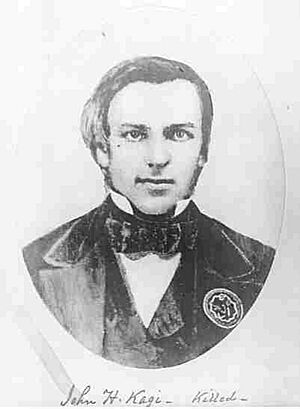John Henry Kagi facts for kids
John Henry Kagi (born March 15, 1835 – died October 17, 1859) was an American lawyer and a strong supporter of abolitionism, which was the movement to end slavery. He was a key helper to John Brown, a famous leader against slavery. Kagi was known as "Secretary of War" in Brown's group. He was only 24 years old when he died during Brown's attack on Harper's Ferry. Before that, he had actively fought against slavery in a violent period known as "Bleeding Kansas". Kagi was also an excellent debater and speaker.
Contents
Kagi's Early Life and Education
John Henry Kagi was born in Bristolville, Ohio, in 1835. His family had Swiss roots. Even though he mostly taught himself, Kagi was one of the best-educated people in John Brown's group.
He was a stenographer, which means he could write very quickly using a special system. This skill was useful for a reporter. Kagi worked as an editor for the Topeka Tribune and wrote for important newspapers like the New York Post and the New York Tribune. He often signed his articles with just "K."
Kagi was also good at business. He held different beliefs than many people at the time; he was agnostic, meaning he wasn't sure if God existed. In 1854–55, he taught school in Hawkinstown, Virginia. However, he had to leave because of his strong anti-slavery views.
Fighting Against Slavery
In 1855, Kagi traveled west to stay with his sister and her husband in Nebraska City, Nebraska. Their home, the Mayhew Cabin, was an important stop on the Underground Railroad. This was a secret network that helped enslaved people escape to freedom.
While living there, Kagi became a lawyer. By 1856, he moved to Kansas to join others who were fighting to make Kansas a free state, not a slave state. This time was very violent, earning the name "Bleeding Kansas." Kagi joined a group fighting for freedom and later met John Brown in Lawrence, Kansas. Kagi and another man named Aaron Stevens became two of Brown's closest advisors.
On August 16, 1856, Kagi took part in an attack on "Fort Titus," the home of a pro-slavery leader. A month later, Kagi was captured by the United States Army and held in prisons in Kansas. He managed to escape from one of these prisons. In January 1857, Kagi was shot in a gunfight but survived because a notebook in his pocket stopped the bullet. He also shot a pro-slavery judge in the leg during this fight.
Later, Kagi helped Brown try to start a military school in Tabor, Iowa. He also received military training in a Quaker community in Iowa.
Planning the Raid
Brown and his group went to Canada to plan their efforts. In May 1858, in a black church in Chatham, Ontario, they created Brown's "Provisional Constitution and Ordinances for the people of the United States." Kagi was chosen as the Secretary of War for this group.
Kagi and Brown returned to Kansas with their men. In November 1858, Kagi helped defend their cabin from an armed group while Brown was away. On December 20, 1858, Brown led a group of men, and Kagi led another, into Missouri to free enslaved people. Brown's group freed ten slaves, while Kagi's group freed one.
As they planned the raid on Harper's Ferry, Kagi was in charge of buying and storing weapons in Chambersburg, Pennsylvania. He lived there with Brown. On August 19, Brown and Kagi met with famous abolitionist Frederick Douglass to talk about the raid. Douglass later said he advised them not to go through with it.
Death at Harper's Ferry
Kagi was killed by soldiers during the Harper's Ferry raid. He was trying to escape across the Shenandoah River when he was shot. His body was first buried near the river with other raiders who died. Forty years later, in 1899, Kagi's remains and those of nine other raiders were moved and reburied in a shared grave next to John Brown's grave at the John Brown Farm State Historic Site.
In Popular Culture
John Henry Kagi has appeared as a character in several novels:
- Raising Holy Hell (1995)
- Flashman and the Angel of the Lord (1996)
- Cloudsplitter (1998)
- The Good Lord Bird (2013)


